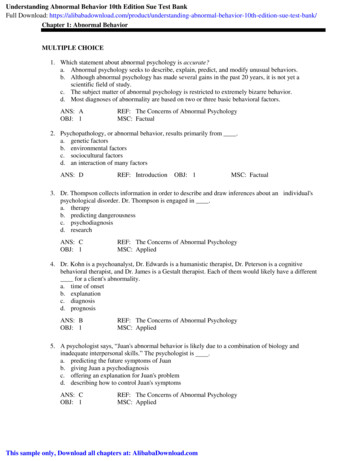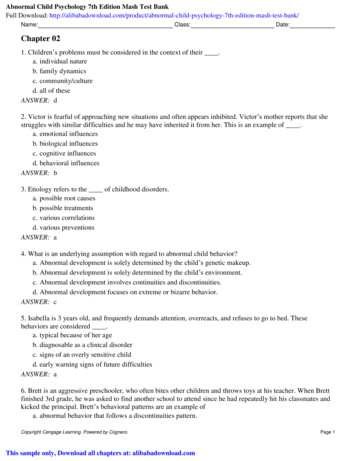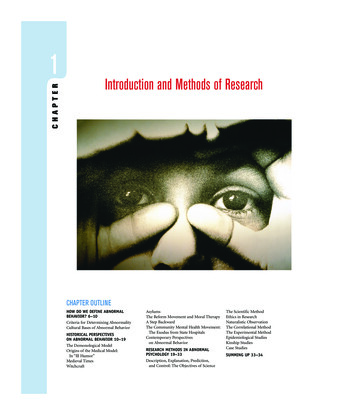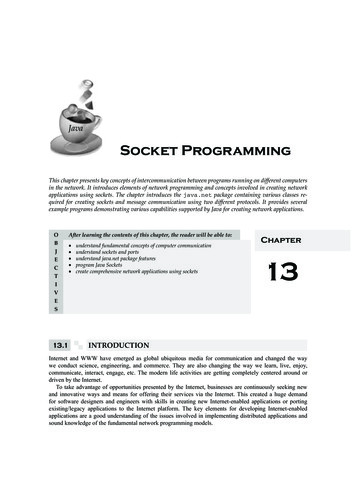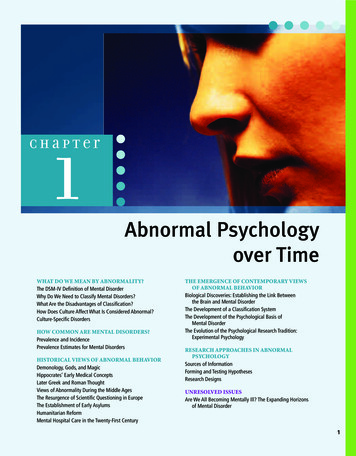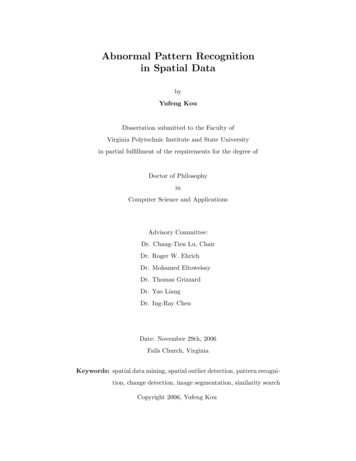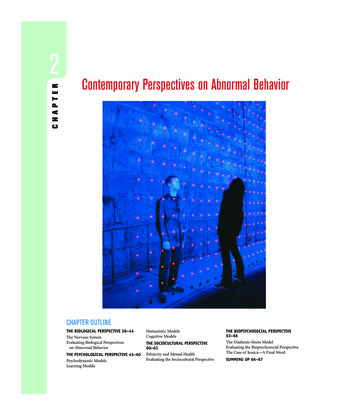
Transcription
NEVIDMC02 036-067HR.qxd28-09-200714:09Page 36CHAPTER2Contemporary Perspectives on Abnormal BehaviorCHAPTER OUTLINETHE BIOLOGICAL PERSPECTIVE 38–44The Nervous SystemEvaluating Biological Perspectiveson Abnormal BehaviorTHE PSYCHOLOGICAL PERSPECTIVE 45–60Psychodynamic ModelsLearning ModelsHumanistic ModelsCognitive ModelsTHE SOCIOCULTURAL PERSPECTIVE60–63Ethnicity and Mental HealthEvaluating the Sociocultural PerspectiveTHE BIOPSYCHOSOCIAL PERSPECTIVE63–66The Diathesis–Stress ModelEvaluating the Biopsychosocial PerspectiveThe Case of Jessica—A Final WordSUMMING UP 66–67
NEVIDMC02 036-067HR.qxd28-09-200714:09Page 37T R U T H or F I C T I O NJessica’s “Little Secret”I don’t want Ken (her fiancé) to find out. I don’t want to bring this into the marriage.I probably should have told him, but I just couldn’t do it. Every time I wanted to Ijust froze up. I guess I figured I’d get over this before the wedding. I have to stopbingeing and throwing up. I just can’t stop myself. You know, I want to stop, but Iget to thinking about the food I’ve eaten and it sickens me. I picture myself gettingall fat and bloated and I just have to rush to the bathroom and throw it up. I wouldgo on binges, and then throw it all up. It made me feel like I was in control, butreally I wasn’t.I have this little ritual when I throw up. I go to the bathroom and run the waterin the sink. Nobody ever hears me puking. It’s my little secret. I make sure to clean upreally well and spray some Lysol before leaving the bathroom. No one suspects I have aproblem. Well, that’s not quite true. The only one who suspects is my dentist. He saidmy teeth were beginning to decay from stomach acid. I’m only 20 and I’ve got rottingteeth. Isn’t that awful?. . . Now I’ve started throwing up even when I don’t binge. Sometimes just eatingdinner makes me want to puke. I’ve just got to get the food out of my body—fast, youknow. Right after dinner, I make some excuse about needing to go to the bathroom.It’s not every time but at least several times a week. After lunch sometimes, too. Iknow I need help. It’s taken me a long time to come here, but you know I’m gettingmarried in three months and I’ve got to stop.—Jessica, a 20-year-old communications majorT F Recent research shows that mostpsychological disorders are caused by defective genes. (p. 45)T F Punishment does not eliminateundesirable behavior. (p. 55)T F Children may acquire a distortedself-concept that mirrors what others expectthem to be, but that does not reflect whothey truly are. (p. 57)T F According to a leading cognitivetheorist, emotional distress is caused bybeliefs people hold about negative lifeexperiences, not by the experiences themselves. (p. 59)T F Black Americans have higher ratesof psychological disorders than WhiteEuropeans Americans, even when we accountfor income differences between these groups.(p. 62)Source: From the Author’s FilesJESSICA EXCUSES HERSELF FROM THE DINNER TABLE, GOES TO THE BATHROOM, STICKS A FINGERdown her throat to gag, and throws up her dinner. Sometimes she binges first and thenforces herself to throw up. You’ll recall that in Chapter 1 we described the criteria thatmental health professionals generally use to classify behavior patterns as abnormal.Jessica’s behavior clearly meets several of these criteria. Bingeing and throwing up is asource of personal distress and is maladaptive in the sense that it can lead to serioushealth consequences, such as decaying teeth (see Chapter 10), and social consequences(which is why she kept it a secret and feared it would damage her forthcoming marriage). It is also statistically infrequent, although perhaps not as infrequent as youmight think. Jessica was diagnosed with bulimia, a type of eating disorder that we discuss in Chapter 10.How can we understand such unusual and maladaptive behavior? In this chapter weexamine contemporary approaches to understanding abnormal behavior from thevantage points offered by the biological, psychological, and sociocultural perspectives.Each perspective provides a window for examining abnormal behavior, but none captures a complete view of the subject. Many scholars today believe that abnormal behavior patterns are complex phenomena that are best understood by taking into accountthe contributions of multiple factors representing these different perspectives, ratherthan from any one causal factor.Since earliest times, humans have sought explanations for strange or deviant behavior. As we saw in Chapter 1, through the Middle Ages, most people believed that abnormal behavior was caused by demons and other supernatural forces. But even in ancienttimes, some scholars, such as Hippocrates and Galen, looked for natural explanationsof abnormal behavior. Today, of course, superstition and demonology have given wayto theoretical models from the natural and social sciences. These approaches pave theway not only for a scientifically based understanding of abnormal behavior but also forways of treating people with psychological disorders.37
NEVIDMC02 036-067HR.qxd382-10-20078:55Page 38Chapter 2In this chapter we examine the biological, psychological, and sociocultural perspectives on abnormal behavior. Each perspective provides a window for examining abnormal behavior, but none captures a complete view of the subject. Many scholars todaybelieve that abnormal behavior patterns are complex phenomena that are best understood by taking into account these multiple perspectives. As we shall see in Chapter 4,the major biological and psychological perspectives on abnormal behavior give rise todifferent ways of treating these problems.THE BIOLOGICAL PERSPECTIVEThe biological perspective, inspired by scientists and physicians since the time ofHippocrates, focuses on the biological underpinnings of abnormal behavior and theuse of biologically based approaches, such as drug therapy, to treat psychological disorders. The biological perspective gave rise to the development of the medical model,which remains today a powerful force in contemporary understandings of abnormalbehavior. People who adopt the medical model subscribe to the belief that abnormalbehaviors represent symptoms of underlying disorders or diseases, called mental illnesses, that have biological root causes. The medical model is not synonymous with thebiological perspective, however. We can speak of biological perspectives withoutadopting the tenets of the medical model. For example, a behavior pattern such as shyness may have a strong genetic (biological) component but not be considered a “symptom” of any underlying “disorder” or illness.Our understanding of the biological underpinnings of abnormal behavior hasgrown in recent years. In Chapter 1 we focused on the methods of studying the role ofheredity or genetics. Genetics plays a role in many forms of abnormal behavior, as weshall see throughout the text.We also know that other biological factors, especially the functioning of the nervous system, are involved in the development of abnormal behavior. To better understand the role of the nervous system in abnormal behavior patterns, we first need tolearn how the nervous system is organized and how nerve cells communicate with eachother. In Chapter 5 we examine another body system, the endocrine system, and theimportant roles that it plays in the body’s response to stress.The Nervous Systemneurons Nerve cells.dendrites The rootlike structures at theends of neurons that receive nerve impulsesfrom other neurons.axon The long, thin part of a neuron alongwhich nerve impulses travel.terminals The small branching structures atthe tips of axons.neurotransmitters Chemical substancesthat transmit messages from one neuron toanother.synapse The junction between one neuronand another through which nerve impulsespass.Perhaps if you did not have a nervous system, you would never feel nervous—but neither would you see, hear, or move. However, even calm people have nervous systems.The nervous system is made up of neurons, nerve cells that transmit signals or “messages” throughout the body. These messages allow us to sense an itch from a bug bite,coordinate our vision and muscles to ice skate, write a research paper, solve a mathproblem, and in the case of hallucinations, hear or see things that are not really there.Every neuron has a cell body that contains the nucleus of the cell and metabolizesoxygen to carry out the work of the cell (see Figure 2.1). Short fibers called dendritesproject from the cell body to receive messages from adjoining neurons. Each neuronhas an axon that projects trunklike from the cell body. Axons can extend as long as several feet, if they are conveying messages between the toes and the spinal cord. Axonsterminate in small branching structures that are aptly called terminals. Neuronsconvey messages in one direction, from the dendrites or cell body along the axon to theaxon terminals. The messages are then conveyed from the terminals to other neurons,muscles, or glands.Neurons transmit messages to other neurons by means of chemical substancescalled neurotransmitters. Neurotransmitters induce chemical changes in receivingneurons. These changes cause axons to conduct the messages in electrical form.The junction or small gap between a transmitting neuron and a receiving neuronis termed a synapse. The message does not jump across the synapse like a spark.Instead, axon terminals release neurotransmitters into the cleft like myriad ships casting off into the seas (Figure 2.2).
NEVIDMC02 036-067HR.qxd2-10-20078:56Page 39Contemporary Perspectives on Abnormal BehaviorDendriteAxonTerminalsMyelin SheathAxonCellNucleusCellBodyAxonHillockAxonFIGURE 2.1 Anatomy of a neuron.The three basic parts of the neuron are the cell body, the dendrites, and the axon. The axon of thisneuron is wrapped in a myelin sheath, which insulates it from the bodily fluids surrounding theneuron and facilitates transmission of neural impulses (messages that travel within the neuron).DendriteAxonAxonTerminalCell transmittersReceptorSiteDendrite or Cell BodyFIGURE 2.2 Transmission of neural impulses across the synapse.The diagram here shows the structure of the neuron and the mode of transmission of neural impulsesbetween neurons. Neurons transmit messages, or neural impulses, across synapses, which consistof the axon terminal of the transmitting neuron, the gap or synapse between the neurons, andthe dendrite of the receiving neuron. The “message” is carried by neurotransmitters that arereleased into the synapse and taken up by receptor sites on the receiving neuron. Patterns offiring of many thousands of neurons give rise to psychological events such as thoughts and mentalimages. Different forms of abnormal behavior are associated with irregularities in the transmission or reception of neural messages.39
NEVIDMC02 036-067HR.qxd401-10-200711:15Page 40Chapter 2TABLE 2.1Neurotransmitter Functions and Relationshipswith Abnormal Behavior Patternsreceptor site A part of a dendrite on areceiving neuron that is structured to receivea neurotransmitter.central nervous system The brain andspinal cord.peripheral nervous system The somaticand autonomic nervous systems.Associations withAbnormal BehaviorNeurotransmitterFunctionsAcetylcholine (ACh)Control of muscle contractionsand formation of memoriesReduced levels found inpatients with Alzheimer’sdisease (see Chapter 15)DopamineRegulation of musclecontractions and mentalprocesses involving learning,memory, and emotionsOverutilization of dopaminein the brain may be involvedin the development of schizophrenia (see Chapter 12)NorepinephrineMental processes involved inlearning and memoryIrregularities linked withmood disorders such asdepression (see Chapter 8)SerotoninRegulation of mood states,satiety, and sleepIrregularities are implicated indepression and eating disorders (see Chapters 8 and 10)Each kind of neurotransmitter has a distinctive chemical structure. It will fit onlyinto one kind of harbor, or receptor site, on the receiving neuron. Consider the analogy of a lock and key. Only the right key (neurotransmitter) operates the lock, causingthe postsynaptic (receiving) neuron to forward the message.When released, some molecules of a neurotransmitter reach port at receptor sites ofother neurons. “Loose” neurotransmitters may be broken down in the synapse byenzymes, or be reabsorbed by the axon terminal (a process termed reuptake), to prevent the receiving cell from continuing to fire.Psychiatric drugs, including drugs used to treat anxiety, depression, and schizophrenia, work by affecting the availability of neurotransmitters in the brain (Snyder, 2002).Consequently, many scientists suspect that irregularities in the workings of neurotransmitter systems in the brain play important roles in the development of theseabnormal behavior patterns (see Table 2.1).Depression is linked to chemical imbalances in the brain involving irregularities inthe functioning of several neurotransmitters, especially serotonin (Bremner et al., 2003;Harmer et al., 2003; Meyer et al., 2003) (see Chapter 8). Serotonin is a key brain chemical involved in regulating moods, so it is not surprising that it would play a role indepression (Gupta, 2003). The most widely used antidepressant drugs—Prozac andZoloft—belong to a class of drugs that increase the availability of serotonin in the brain.Serotonin is also linked to anxiety disorders, sleep disorders, and eating disorders.Alzheimer’s disease, a brain disease in which there is a progressive loss of memory andcognitive functioning, is associated with reductions in the levels of the neurotransmitteracetylcholine in the brain (see Chapter 15). Irregularities involving the neurotransmitterdopamine are implicated in the development of schizophrenia (see Chapter 12).Antipsychotic drugs used to treat schizophrenia apparently work by blockingdopamine receptors in the brain.Although neurotransmitter systems are implicated in many psychological disorders,the precise causal mechanisms remain to be determined.Parts of the Nervous System The nervous system consists of two major parts, thecentral nervous system and the peripheral nervous system. The central nervous systemconsists of the brain and spinal cord. The peripheral nervous system is made up of nervesthat (a) receive and transmit sensory messages (messages from sense organs such as theeyes and ears) to the brain and spinal cord, and (b) transmit messages from the brain or
NEVIDMC02 036-067HR.qxd1-10-200711:17Page 41Contemporary Perspectives on Abnormal Behavior41The Nervous SystemCentral Nervous SystemPeripheral Nervous SystemThe body's master control unitThe body's link to the outside worldSpinal CordA column of nervesbetween the brainand peripheralnervous systemBrainDivided into threemajor parts; the lowerpart or hindbrain, themidbrain, and theforebrainThe AutonomicNervous SystemRegulates involuntarybodily processes,including heart raterespiration, digestionand pupil contraction;operates automaticallywithout consciousdirectionSympatheticNervous SystemMobilizes bodilyresources in responseto threat by speedingup heart rate andrespiration and drawingstored energy frombodily reservesThe SomaticNervous SystemCarries sensoryinformation from sensoryorgans to the centralnervous system (CNS)and relays motor(movement) commandsto muscles; controlsvoluntary movementsParasympatheticNervous SystemReplenishes bodilyresources by promotingdigestion and bodilyprocessesFIGURE 2.3 The organization of the nervous system.Source: Adapted from J. S. Nevid, Psychology: Concepts and Applications, Second Edition (Boston:Houghton Mifflin Co., 2007), p. 56. Reprinted by permission.spinal cord to the muscles, causing them to contract, and to glands, causing them tosecrete hormones. The organization of the nervous system is represented in Figure 2.3.Central Nervous System We begin our overview of the parts of the central nervoussystem with the back of the head, where the spinal cord meets the brain, and work forward (see Figure 2.4). The lower part of the brain, or hindbrain, consists of the medulla,pons, and cerebellum. The medulla plays roles in such vital life-support functions asheart rate, respiration, and blood pressure. The pons transmits information about bodymovement and is involved in functions related to attention, sleep, and respiration.Behind the pons is the cerebellum (Latin for “little brain”). The cerebellum regulates balance and motor (muscle) behavior. Injury to the cerebellum can impair yourability to coordinate your movements, causing stumbling and loss of muscle tone.The midbrain lies above the hindbrain and contains nerve pathways linking thehindbrain to the upper region of the brain, called the forebrain. The reticular activatingsystem (RAS) starts in the hindbrain and rises through the midbrain into the lowerpart of the forebrain. The RAS is a weblike network of neurons (nerve cells) that playimportant roles in regulating sleep, attention, and states of arousal. Stimulation of theRAS heightens alertness. On the other hand, use of depressant drugs, such as alcohol,dampens central nervous system activity, which reduces RAS activity and can inducestates of grogginess or even stupor. (Effects of depressants and other drugs are discussed further in Chapter 9.)medulla An area of the hindbrain involvedin regulation of heartbeat and respiration.pons A structure in the hindbrain involvedin respiration.cerebellum A structure in the hindbraininvolved in coordination and balance.reticular activating system Brainstructure involved in processes of attention,sleep, and arousal.
NEVIDMC02 036-067HR.qxd4228-09-200714:09Page 42Chapter thalamusSensory AreaCentral FissureMotor talLobeCerebellumPonsMedullaTemporalLobeSpinal Cord(A)(B)FIGURE 2.4 The geography of the brain.Part A shows parts of the hindbrain, midbrain, and forebrain. Part B shows the four lobes of thecerebral cortex: frontal, parietal, temporal, and occipital. In B, the sensory (tactile) and motorareas lie across the central fissure from one another. Researchers are investigating the potentialrelationships between various patterns of abnormal behavior and irregularities in the formation orfunctioning of the structures of the brain.thalamus A structure in the forebraininvolved in relaying sensory information tothe cortex and in processes related to sleepand attention.hypothalamus A structure in the forebraininvolved in regulating body temperature,emotion, and motivation.limbic system A group of forebrainstructures involved in learning, memory,and basic drives.basal ganglia An assemblage of neuronslocated between the thalamus and cerebrum,involved in coordinating motor (movement)processes.cerebrum The large mass of the forebrain,consisting of the two cerebral hemispheres.cerebral cortex The wrinkled surface areaof the cerebrum responsible for processingsensory stimuli and controlling higher mentalfunctions, such as thinking and use oflanguage.The large frontal area of the brain, called the forebrain, includes such structures asthe thalamus, hypothalamus, limbic system, basal ganglia, and cerebrum. Thethalamus relays sensory information (such as tactile and visual stimulation) to thehigher regions of the brain. The thalamus, in coordination with the RAS, is alsoinvolved in regulating sleep and attention.The hypothalamus (hypo meaning “under”) is a tiny, pea-sized structure locatedunder the thalamus. Despite its small size (it weighs a mere four grams), the hypothalamus plays a key role in many vital bodily functions, including regulation of body temperature, concentration of fluids in the blood, and reproductive processes, as well asemotional and motivational states. By implanting electrodes in parts of the hypothalamus of animals and observing the effects when a current is switched on, researchershave found that the hypothalamus is involved in a range of motivational drives andbehaviors, including hunger, thirst, sex, parenting behaviors, and aggression.The hypothalamus, together with parts of the thalamus and other nearby interconnected structures, make up the brain’s limbic system. The limbic system plays importantroles in emotional processing and memory. It also serves important functions regulatingmore basic drives involving hunger, thirst, and aggression. The basal ganglia lie in frontof the thalamus and are involved in regulating postural movements and coordination.The cerebrum is the brain’s crowning glory. It is responsible for higher mental functions, such as thinking and problem solving, and also accounts for the delightfullyrounded shape of the human head. The surface of the cerebrum is convoluted with ridgesand valleys. This surface area is called the cerebral cortex. It is the thinking, planning,and executive center of the brain, as well as the seat of consciousness and the sense of self.Structural or functional abnormalities of brain structures are involved in various formsof abnormal behavior. For example, investigators find abnormalities in parts of the cerebralcortex and limbic system in schizophrenia patients (discussed in Chapter 12). The hypothalamus is implicated in certain types of sleep disorders (see Chapter 10), and deterioration ofthe basal ganglia is associated with Huntington’s disease, a degenerative disease that can leadto disturbances of mood and paranoia and even to dementia (see Chapter 15). These arebut a few of the brain-behavior relationships we shall discuss in later sections of this text.
NEVIDMC02 036-067HR.qxd1-10-200711:19Page 43Contemporary Perspectives on Abnormal BehaviorPeripheral Nervous System The peripheral nervous system is a network of neuronsconnecting the brain to our sense organs—our eyes, ears, and so on—as well as ourglands and muscles. These neural pathways allows us to both sense the world aroundus and act upon it by using our muscles to move our limbs. The peripheral nervoussystem consists of two main parts or divisions, called the somatic nervous system andthe autonomic nervous system (see Figure 2.3).The somatic nervous system transmits messages from our sensory organs to thebrain for processing, leading to the experience of visual, auditory, tactile, and othersensations. Commands emanating from the brain pass downward through the spinalcord to nerves of the somatic nervous system that connect to our muscles, allowing usto voluntarily control our movements, such as when raising an arm or walking.Psychologists are especially interested in the workings of the autonomic nervoussystem (ANS) because of its role in emotional processing. Autonomic means “automatic.”The ANS regulates the glands and involuntary processes such as heart rate, breathing,digestion, and dilation of the pupils of the eyes, even when we are sleeping.The ANS has two branches, the sympathetic nervous system and theparasympathetic nervous system. These have mostly opposing effects. Many organsand glands are served by both branches of the ANS. The sympathetic division is mostinvolved in processes that mobilize the body’s resources in times of stress, such as drawing energy from stored reserves to prepare the person to deal with imposing threats ordangers (see Chapter 5). When we face a threatening or dangerous situation, the sympathetic branch of the ANS kicks in by accelerating our heart rate and breathing rateand thereby preparing our body to either fight or flee from a threatening stressor.Sympathetic activation in the face of a threatening stimulus is associated with emotional responses such as fear or anxiety. When we relax, the parasympathetic branchdecelerates the heart rate. The parasympathetic division is most active during processesthat replenish energy reserves, such as digestion. Because the sympathetic branch dominates when we are fearful or anxious, fear or anxiety can lead to indigestion becauseactivation of the sympathetic nervous system curbs digestive activity.The Cerebral Cortex The parts of the brain responsible for higher mental functions,such as thought and use of language, are the two large masses of the cerebrum called theright and left cerebral hemispheres. The outer layer or covering of each hemisphere iscalled the cerebral cortex. (The word cortex literally means “bark” and is so used becausethe cerebral cortex can be likened to the bark of a tree.) Each hemisphere is divided intofour parts, called lobes, as shown in Figure 2.4. The occipital lobe is primarily involved inprocessing visual stimuli; the temporal lobe is involved in processing sounds or auditory stimuli. The parietal lobe is involved in processing sensations of touch, temperature,and pain. The sensory area of the parietal lobe receives messages from receptors in theskin all over the body. Neurons in the motor area (or motor cortex) of the frontal lobecontrol muscular responses, enabling us to move our limbs. The prefrontal cortex (thepart of the frontal lobe that lies in front of the motor cortex) regulates higher mentalfunctions such as thinking, problem solving, and use of language.Evaluating Biological Perspectives on Abnormal BehaviorBiological structures and processes are involved in many patterns of abnormal behavior, as we will see in later chapters. Genetic factors, as well as disturbances in neurotransmitter functioning and underlying brain abnormalities or defects, are implicatedin many psychological disorders. For some disorders, such as Alzheimer’s disease, biological processes play the direct causative role. (Even then, however, the precise causesremain unknown.) But for most disorders, we need to examine the interaction of biological and environmental factors.Genes play important roles in determining our vulnerability or susceptibility topsychological disorders. But genes do not tell the whole story when it comes to understanding the origins of these disorders (Kendler, 2005; Plomin et al., 2003). Scientiststoday are moving past the old “nature–nurture” (gene vs. environment) debate to43somatic nervous system The divisionof the peripheral nervous system that relaysinformation from the sense organs to thebrain and transmits messages from the brainto the skeletal muscles.autonomic nervous system The divisionof the peripheral nervous system thatregulates the activities of the glandsand involuntary functions.sympathetic nervous system Pertainingto the division of the autonomic nervoussystem whose activity leads to heightenedstates of arousal.parasympathetic nervous systemPertaining to the division of the autonomicnervous system whose activity reduces statesof arousal and regulates bodily processesthat replenish energy reserves.
NEVIDMC02 036-067HR.qxd4428-09-200714:09Page 44Chapter 2CONTROVERSIES IN ABNORMAL PSYCHOLOGYIs It All in the Genes?It’s not stretching a point to say that progress in genetic research in recentyears has been nothing less than remarkable. The highlight of these achievements was the cracking of the human genome, the complete genetic blueprint of a human being. The genome consists of the precise chemicalsequence in human DNA—a recipe for determining the features or traits ofhuman beings (International Human Genome, 2001; Wade, 2003b). We arenow able to read the coded instructions that comprise the genetic script of ahuman being. The genome has even been published on the Internet for scientists to use in their studies (Baltimore, 2000).We each possess a unique genetic code and buried within that code aresequences of DNA that are believed to play important roles in determiningour risks of developing many physical and mental disorders (Kendler, 2005).Evidence connects genetic factors to a wide range of psychological disorders,including schizophrenia, bipolar (manic–depressive) disorder, major depression, alcoholism, autism, dementia due to Alzheimer’s disease, anxiety disorders, dyslexia, and antisocial personality disorder (Merikangas & Risch, 2003;NIMH, 2003; Plomin & McGuffin, 2003; Waterworth et al., 2002).Just what it is we inherit that puts us at greater risk of developing psychological disorders is a question that continues to challenge researchers.We shouldn’t think there is any one-to-one relationship between individualgenes and the complex patterns of behavior we recognize as schizophrenia,bipolar disorder, or any other psychological disorders. No, there doesn’tappear to be any one gene that causes schizophrenia or any other psychological disorder. Rather, multiple genes interact in complex ways, affectingunderlying processes involved in brain chemistry and brain structures, whichin turn affect the likelihood of developing psychological disorders.Scientists are seeking to find particular genes involved in psychologicaldisorders such as schizophrenia, depression, and autism (Bunney et al., 2003;Plomin, 2003; Plomin et al., 2003; Tecott, 2003). They hope that one day inthe not-too-distant future, it will be possible to repair defective or harmfulgenes, perhaps by blocking their actions, as well as to enhance the actions ofbeneficial genes (Phillips et al., 2002; Plomin & McGuffin, 2003; Sapolsky, 2003).Against the backdrop of increasing evidence of genetic contributionsacross a wide swath of abnormal behavior, the question remains, “Is it all inthe genes?” More specifically, is the development of psychological disorders amatter of luck in the genetic draw?These questions touch on a long-standing debate in psychology, arguablythe longest debate—the so-called “nature versus nurture” debate. Thedebate has shifted to one pitting nature against nurture to one framed interms of how much of our behavior is a product of nature (genes) and howmuch is a product of nurture (environment). As the long debate continues,let us offer a few key points to consider:1. Genes do not dictate behavioral outcomes. Evidence of a genetic con
of abnormal behavior. Today, of course, superstition and demonology have given way to theoretical models from the natural and social sciences. These approaches pave the way not only for a scientifically based understanding of abnormal behavior but also

